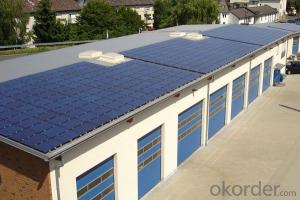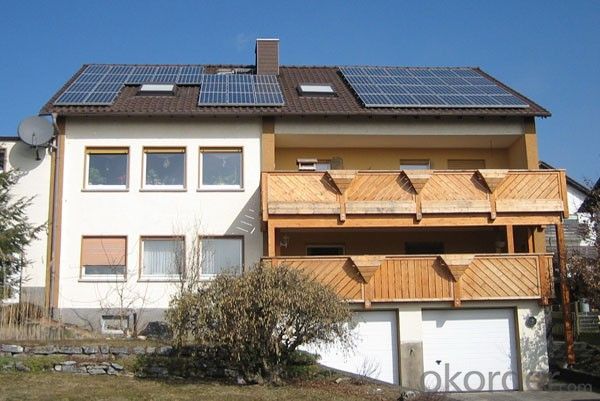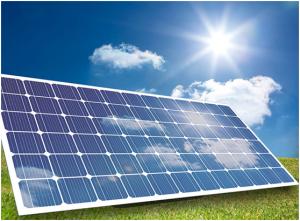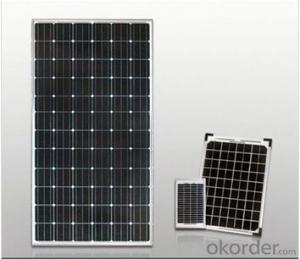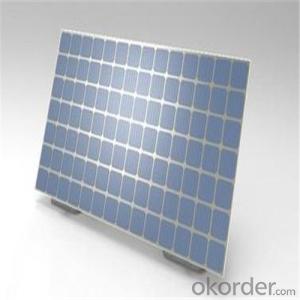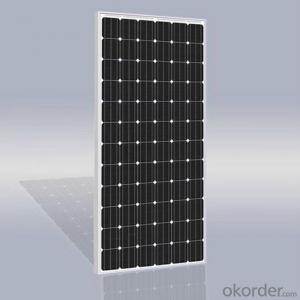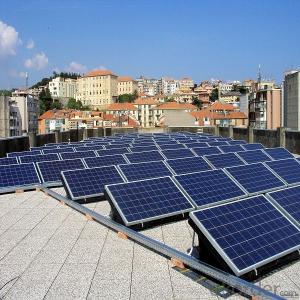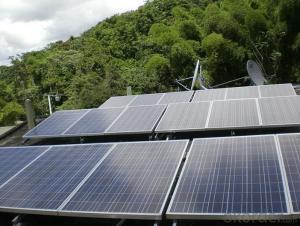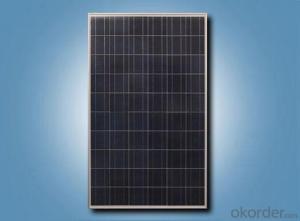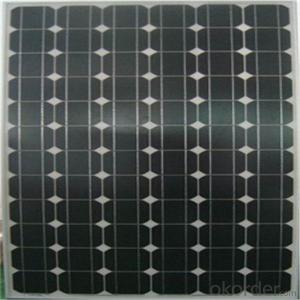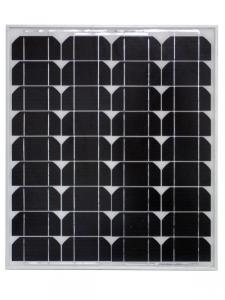Estimate Solar Panels Needed:Poly 220W Solar Panel / 27Vmp Made in China
- Loading Port:
- Shanghai
- Payment Terms:
- TT OR LC
- Min Order Qty:
- 100 watt
- Supply Capability:
- 10000 watt/month
OKorder Service Pledge
OKorder Financial Service
You Might Also Like
Specification
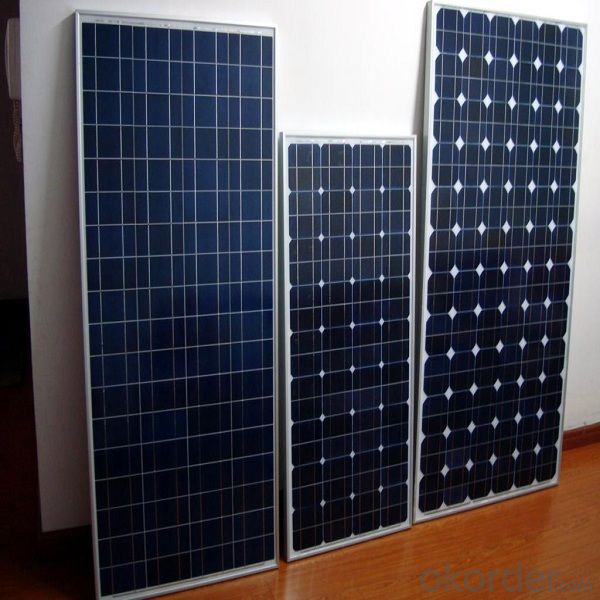
Product Description
Produt name: Poly Crystalline Solar Panel 100W
Product Highlights:
1. Guarantee positive power tolerance (0~+3%)
2. Module can bear snow loads up to 5400Pa and wind loads up to 2400pa
3. High performance under low light conditions (cloudy days, mornings and evenings)
4. Certified by Europe standards of TUV, IEC, CE and British MCS and AUS CEC
5. OEM/ODM available
Specs
| Electrical Characteristics | |
| Maximum Power [Pmax] | 220W |
| Power Tolerance | +/-3% |
| Maximum Power Voltage [Vmp] | 26.8V |
| Maximum Power Current [Imp] | 8.219A |
| Short-Circuit Current [Isc] | 8.67A |
| Open-Circuit Voltage [Voc] | 33.6V |
| Module Efficiency | 15.0% |
| Max. System Voltage | 1000VDC |
| Cell Size and Series | Poly 156*156mm(5 inch) 60pcs (6*10) |
| Temperature Coefficient of Pmax | - 0.48% / º C |
| Temperature Coefficient of Voc | - 0.35% / º C |
| Temperature Coefficient of Isc | 0.04% / º C |
| Mechanical Characteristics | |
| Dimension (mm) | 1640*992*40 |
| Frame | Anodized Aluminium Alloy |
| Glass | 3.2mm,High Transmission,Tempered Glass |
| Junction box & Cable | IP65 Rated Cable: TUV 1x2.5mm2 / UL12AWG,Length:900mm |
| Weight | 19.5Kgs |
Industry-leading Warranty:
Warranty on material and workmanship: 10 years
Guaranteed output of 90% after 12 years and 80% after 25 years.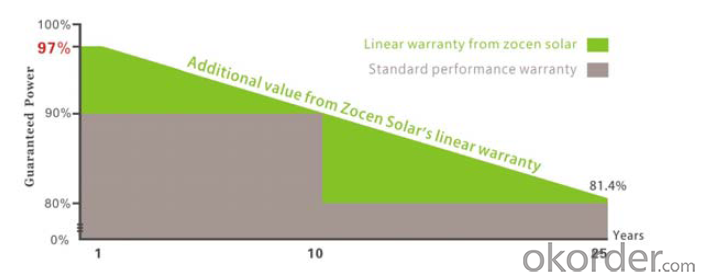
- Q: in a solar panel, i know that the electrons are knocked loose and used as energy, what happens to the protons?
- Here okorder /... Within this structure, the electrons are not really lost from the system. An electron just gets enough energy (from light) to be able to leave its atom, and float freely around the structure. Hence you have electrons in motion, which is the definition of electric current. If the lights go out, the electrons just settle back into one of the atoms that is missing an electron.
- Q: Hello Yahoo, I am doing another one of my wacky inventions however I need something that will give me 2V of power!I don't want to connect loads of AA batteries into a battery holder as this shall run out quickly and become expensive in the long run, I don't want to carry around a big car battery either.I have been searching around on OKorder .uk and found some Solar-Powered 2V Trickle Chargers. These say they shall work on cloudy days (which is perfect as the majority of the time that is all we get!) but could I use it as an independent power source?If I attached the thing I want to run to the solar panel will it supply it with 2V of power?
- If you want to run something from a solar panel, you should remember that the power from the panel is only available when there is reasonable sunshine on the panel. Usually the solar panels are used with solar regulators in order to charge batteries. These batteries are used as energy storage for when the sun is not shining. Now, this does not mean that you cannot drive instruments directly from the solar panel and regulator. To do this, you will need a panel that has sufficient power to drive your instrument. An example is the solar powered garden or fountain pumps. I have driven 2V computer fans directly from the small solar panels - useful for cooling of things such as pool pump housings. The solar regulator is used to convert the solar panel output to a 3.5V output in order to charge lead acid batteries. I have used MPPT regulators (maximum power point tracking) which is more efficient than the standard solar regulator. If you don't use these regulators you may find the solar panel producing up to 7-9V in good sunshine which is not good for your instruments that are expecting 2-3V. Hence the answer to your question is that you will need to have a battery being charged to get useful power from the solar panels via a solar regulator.
- Q: How do solar panels affect the power grid?
- Solar panels can positively impact the power grid by producing clean and renewable energy. When connected to the grid, excess electricity generated by solar panels can be fed back into the system, reducing the overall demand for traditional fossil fuel-based power sources. This not only helps in reducing greenhouse gas emissions but also decreases the strain on the power grid, making it more reliable and sustainable.
- Q: I have to get a lot of information on how solar panels are developed and distributed in America because I have to do two pages on this. Please help me get information in this I really need it!! Thankss...
- The first link below is one of the best sites for recent news about solar panels. You should be able to find stories about solar panels under development today. A little bit of the history: Solar panels have been around for about 50 years now. They were first used to power spacecraft. Solar power for domestic use started to develop rapidly in the 970's during the first oil crisis, but as energy prices fell in the 980's solar development slowed. Most of the large solar panel makers were purchased by large oil companies who seemed not to be too interested in solar. In the late 990's as concerns about both Peak Oil and Global Warming grew there was renewed interest in solar power and a number of new companies were started to develop new kinds of solar panels. Many of these new companies have grown larger than the older solar companies still owned by big oil companies. Over the last 7 years or so growth in the solar market has been explosive with a compound growth rate of almost 40% per year. In 2005 the solar industry for the first time started to consume more silicon than all other electronic industries combined resulting in a world wide silicon shortage that is still with use. New silicon refineries are coming on line and the shortage is expected to diminish by 2008 or 2009. Check out the two links below. They will help you a lot.
- Q: Can solar panels be used for powering a research facility or laboratory?
- Yes, solar panels can be used to power a research facility or laboratory. Solar panels convert sunlight into electricity, providing a sustainable and renewable source of energy. By harnessing the power of the sun, solar panels can generate enough electricity to meet the energy demands of various equipment and appliances used in research facilities and laboratories. Additionally, solar panels can be combined with energy storage systems to ensure continuous power supply even when sunlight is not available.
- Q: If my school uses 88240kWh of electricity per month and I have 000 50W solar panels running for 6 hours a day, does it mean it will take 88240kWh / {{[(50W x 3600s)*000]/000}kWh x 6} number of hours to generate that much electricity (88240kWh)?
- running six hours a day doesn't mean much. You need to look at the solar insulation charts for your school's geographical location to come up with a better factor. The easiest number for you to use is sun hours. For example, Washington DC averages 4.23 hours. Do a Yahoo search for sun hours and you should find lots of charts. Solar panels rated at 50W give this output at full sun near noon at full brightness (no clouds). The sun hour factor makes it easy to find the equivalent number of full brightness hours. So, using Washington DC as an example you have: 000 panels * 50W * 4.23 sunhours/day = 634kWh a day on average. You state your school uses 88240kWh/month which is 6274kWh a day. This would mean you need ten times more solar panels since there is no way to get more daylight. Be careful to put in all the units in your formula and cancel them out to make sure you don't end up with a nonsense result. The title of the question would be answered as followed: 50W/000 * 4.23 sunhours/day = 0.63kWh/day or 9kWh per month or 228kWh a year. These are annual averages. If you wanted a specific month, you would need the sun hours for that month. Hope this helps.
- Q: all i want to do is provide enough electricity for 2 fluorescent bulbs i was looking at some 80 watt panels how many of those would i need and what else do i need for storing the electricity for use at nite? and how much would it all cost?
- The solar panels are made in China because there are fewer environmental regulations and cheap coal power. It takes a lot of energy to melt silicon and there are toxic waste products. It would be three to five times more expensive to make the panels in the US ( three times is just for reprocessing the toxic wastes ). Solar cell made in China are about $2 a watt, perhaps as low as $ a watt but in truth the claims for $ a watt or less solar panels as in thin film solar panels have much lower efficiency and require perhaps ten times more surface area.
- Q: Can solar panels be used in areas with high levels of wind-blown debris?
- Yes, solar panels can be used in areas with high levels of wind-blown debris. However, it is important to ensure that the panels are properly installed and maintained to withstand the impact of debris. Regular cleaning and inspection may be required to prevent any obstruction or damage to the panels, ensuring their optimal performance.
- Q: Can solar panels power my entire home?
- Yes, solar panels can power your entire home. However, the feasibility of this depends on various factors such as the size of your home, the amount of sunlight available in your area, the efficiency and capacity of the solar panels, and your energy consumption patterns. It is recommended to consult with a professional to assess your specific needs and design a solar system that can meet the energy requirements of your entire home.
- Q: How do solar panels affect the property's resale time?
- Solar panels can significantly impact a property's resale time by reducing energy costs, increasing the property value, and attracting environmentally conscious buyers.
Send your message to us
Estimate Solar Panels Needed:Poly 220W Solar Panel / 27Vmp Made in China
- Loading Port:
- Shanghai
- Payment Terms:
- TT OR LC
- Min Order Qty:
- 100 watt
- Supply Capability:
- 10000 watt/month
OKorder Service Pledge
OKorder Financial Service
Similar products
Hot products
Hot Searches
Related keywords
